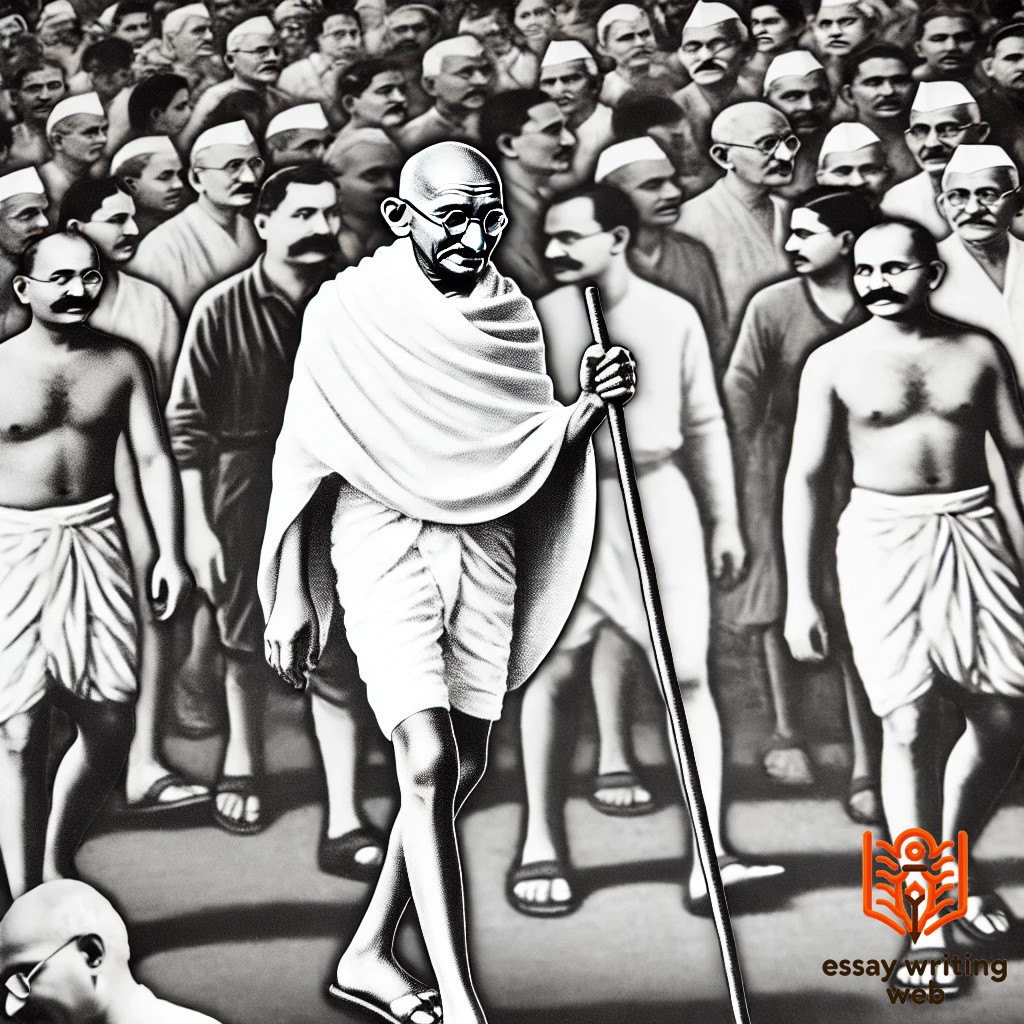 Essay Writing Web
Essay Writing Web
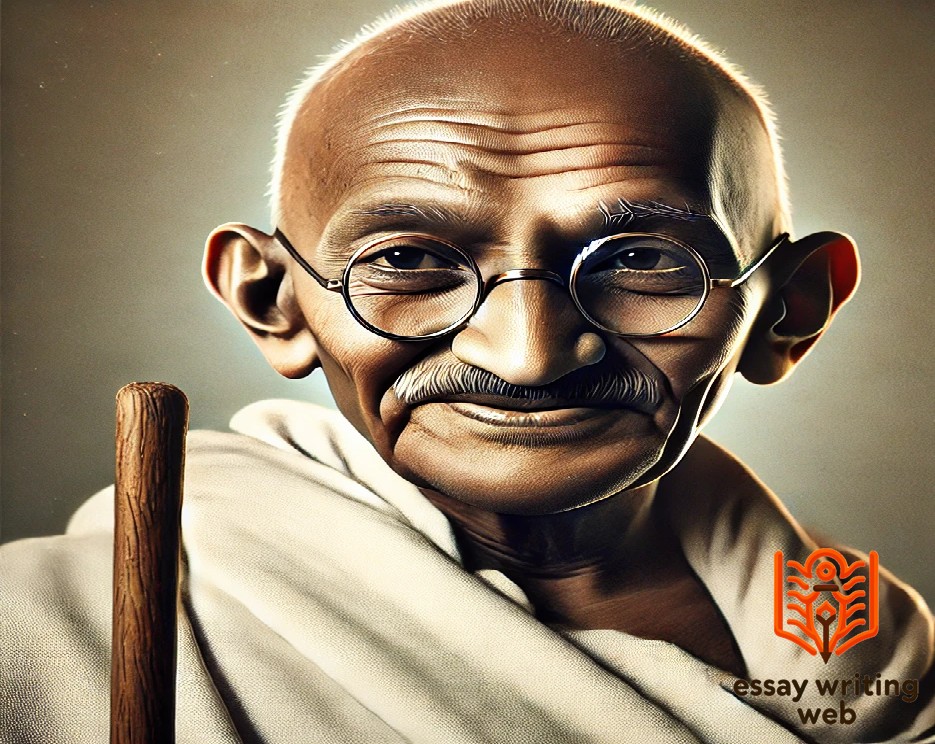
 05-09-2024
05-09-2024
 www.essaywritingweb.com
www.essaywritingweb.com
Mahatma Gandhi fondly known as the Father of the Nation is one of the most revered figures in Indian history. His life and principles have left an indelible mark not only on India’s struggle for independence but also on global movements for civil rights and justice. Born on October 2, 1869, in Porbandar, India, Gandhi emerged as a transformative leader who championed non-violence (Ahimsa) and truth (Satya) as the core of his philosophy. He believed that true freedom could not be attained through violence but through peaceful resistance and moral integrity.
Gandhi’s time in South Africa was instrumental in shaping his ideas on racial equality and social justice. His practice of Satyagraha, a form of non-violent resistance, became the cornerstone of India's independence movement against British colonial rule. He inspired millions to participate in movements like the Salt March and Quit India Movement, which were pivotal in weakening British control.
Beyond his role as a political leader, Gandhi was a social reformer who worked tirelessly for the upliftment of marginalized communities, eradication of untouchability, and promotion of self-reliance through his Swadeshi movement. His simple lifestyle and emphasis on the power of individuals to bring about change continue to resonate worldwide. Mahatma Gandhi’s legacy of peace, tolerance, and justice remains relevant today, as his teachings offer timeless solutions to the challenges of conflict and inequality faced by modern societies.
Mahatma Gandhi's impact on Indian history is unparalleled. His approach to achieving independence through non-violence and civil disobedience revolutionized the freedom struggle and left a lasting influence on India's political, social, and cultural fabric. Gandhi introduced the concept of Satyagraha, which emphasized peaceful resistance against injustice. This method became the backbone of various national movements, including the Non-Cooperation Movement, the Civil Disobedience Movement, and the Quit India Movement, all of which weakened British colonial rule.
Gandhi’s leadership transformed the Indian National Congress into a mass movement, involving people from all walks of life—farmers, laborers, and women—in the struggle for independence. He encouraged self-reliance through his Swadeshi movement, promoting the use of local goods and boycotting British products, which fostered a sense of economic independence and national pride among Indians.
Beyond his political influence, Gandhi's social reforms were equally transformative. He worked tirelessly to eradicate untouchability, promote communal harmony, and uplift the marginalized sections of society. His belief in the power of individuals to initiate change created a culture of responsibility and active citizenship that still resonates in modern India.
Gandhi's vision for an independent India was not just political but moral and spiritual, based on justice, equality, and peace. His teachings inspired future generations of leaders, both in India and globally, and his methods influenced civil rights movements worldwide. In Indian history, Mahatma Gandhi remains a towering figure whose legacy of non-violence continues to guide the nation's path.
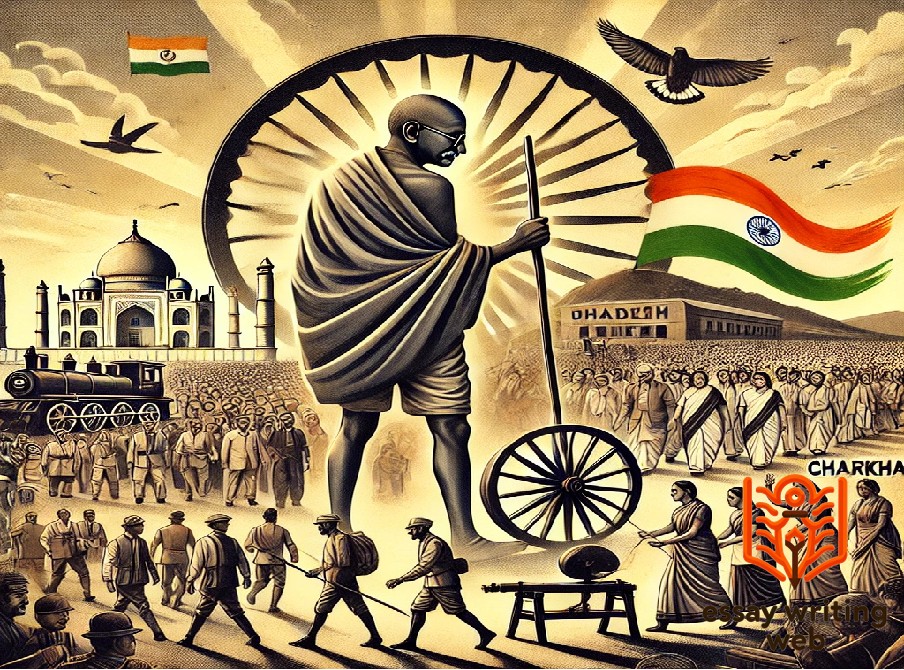
Mahatma Gandhi, born as Mohandas Karamchand Gandhi on October 2, 1869, in Porbandar, a coastal town in Gujarat, India, came from a devout and modest family. His father, Karamchand Gandhi, was a prominent figure in local politics, serving as the Diwan (chief minister) of Porbandar and later in Rajkot. Karamchand was known for his integrity, straightforwardness, and dedication to public service, traits that undoubtedly influenced young Mohandas in his later life. Despite holding a high position, Gandhi’s father led a simple life, which instilled the values of humility and honesty in the family.
Gandhi’s mother, Putlibai, played a crucial role in shaping his moral and spiritual character. She was deeply religious and a devout follower of Vaishnavism, a tradition that emphasized compassion, vegetarianism, and non-violence—principles that Gandhi adopted as the foundation of his philosophy. Her frequent fasting, prayers, and dedication to helping others left a profound impression on young Gandhi, nurturing his later beliefs in self-discipline, service, and moral living.
Gandhi was the youngest of four siblings, growing up in a household that valued education, duty, and strong moral principles. His upbringing in a family that balanced religious devotion with political responsibility laid the groundwork for his future as a leader of India’s independence movement. His early years, filled with exposure to both the public and private responsibilities of his parents, played a formative role in shaping the character of one of the most influential figures in history.
Mahatma Gandhi's education, both in India and abroad, played a significant role in shaping his worldview and philosophy. He began his schooling in his hometown of Porbandar and later in Rajkot, where he received a basic education in traditional subjects like arithmetic, history, and geography. As a student, Gandhi was quiet and unremarkable but showed a keen sense of responsibility and discipline. His early education in India laid the foundation for his ethical and moral development, heavily influenced by the values of truth and non-violence instilled in him by his family and community.
In 1888, at the age of 19, Gandhi embarked on a transformative journey to England to study law at University College London. This move was driven by his desire to become a barrister, a respectable profession in colonial India. While studying in England, Gandhi was exposed to Western philosophies, ideas of justice, and the importance of individual rights. It was here that he encountered the works of philosophers like Tolstoy, Ruskin, and Thoreau, whose writings would later influence his political ideology. During his time abroad, Gandhi also adopted a vegetarian lifestyle and became involved in organizations promoting simple living and ethical principles.
Upon completing his studies in 1891 Mahatma Gandhi returned to India as a qualified lawyer. However, it was his time in London and the exposure to diverse ideas that deepened his commitment to truth, non-violence, and social justice, principles he later applied in his fight for India's independence.
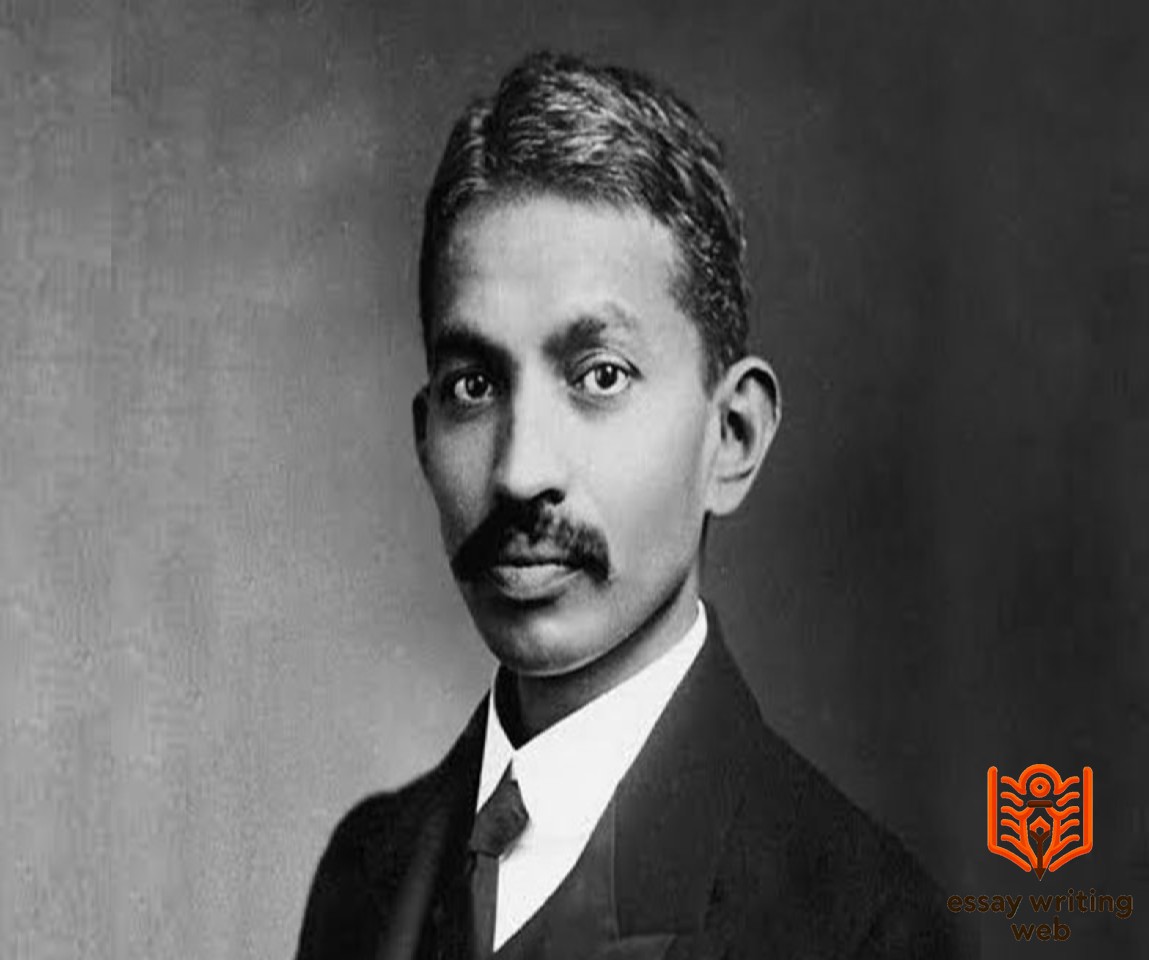
Mahatma Gandhi’s journey to South Africa in 1893 marked a pivotal chapter in his life and the evolution of his philosophy of non-violence and justice. At the age of 24, Gandhi accepted a year-long contract to work as a legal advisor for an Indian firm in South Africa. His initial intention was to pursue a successful career as a lawyer, but his experiences in South Africa transformed his worldview and ignited his commitment to fighting racial injustice.
Upon his arrival, Gandhi encountered firsthand the systemic racial discrimination faced by the Indian community and other people of color. The most notable incident occurred when he was forcibly removed from a first-class train compartment despite holding a valid ticket, simply because of his race. This moment was a turning point, stirring within him a deep sense of injustice. It was here that Gandhi decided to stay in South Africa longer than planned, dedicating himself to the struggle for equal rights.
During his 21 years in South Africa, Gandhi developed the concept of Satyagraha, or non-violent resistance, as a powerful tool to combat oppression. He organized protests, led campaigns, and mobilized the Indian community against discriminatory laws such as the Black Act, which required all Indians to carry identity documents. His efforts eventually succeeded in gaining concessions from the South African government.
Gandhi’s experiences in South Africa shaped him into a leader of global renown, laying the foundation for his future role in India’s struggle for independence. His commitment to truth and non-violence became his guiding principles for the rest of his life.
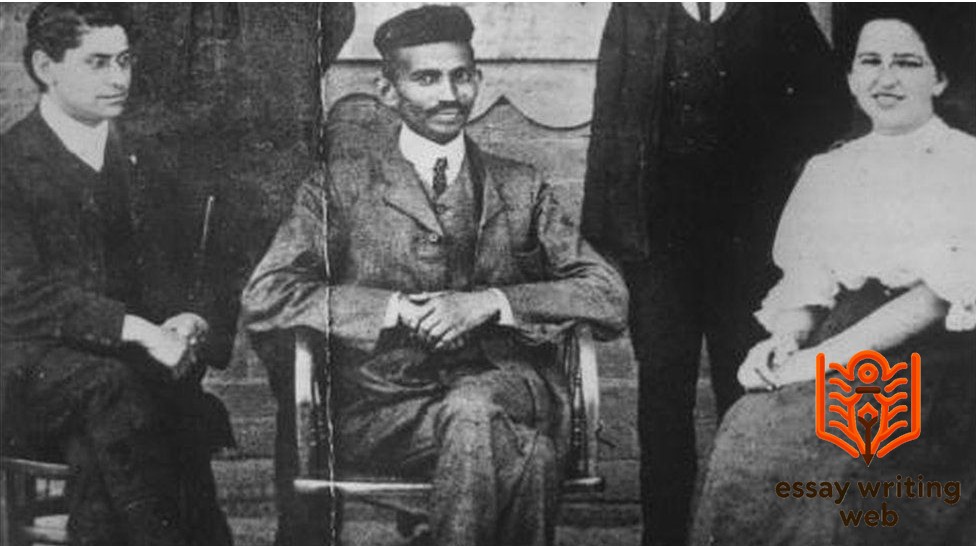
Mahatma Gandhi’s return to India in 1915 marked the beginning of transformative era in the Indian freedom struggle. After spending 21 years in South Africa, where he successfully fought racial discrimination through his philosophy of Satyagraha (non-violent resistance), Gandhi returned to his homeland with a renewed sense of purpose. He was warmly welcomed by Indians, who were aware of his success abroad and eager for his leadership in their quest for independence from British colonial rule.
Upon his return, Gandhi spent the initial years traveling extensively across India, understanding the struggles of the common people, particularly farmers, laborers, and the rural poor. His first major involvement in Indian politics came with the Champaran Satyagraha in 1917, where he led a non-violent movement to support indigo farmers oppressed by British landlords. This success brought him national recognition and strengthened his resolve to use non-violent resistance as a means to fight for India’s freedom.
Gandhi soon became the face of the Indian National Congress and spearheaded several landmark movements, including the Non-Cooperation Movement (1920), Civil Disobedience Movement (1930), and Quit India Movement (1942). His call for peaceful protests, boycotts of British goods, and the promotion of Swadeshi (self-reliance) resonated with millions of Indians, uniting people from different regions, castes, and religions under the banner of non-violent struggle.
Gandhi’s leadership was instrumental in weakening British control over India, ultimately leading to the country’s independence in 1947. His legacy as a champion of peace, truth, and justice remains deeply woven into India’s historical narrative.
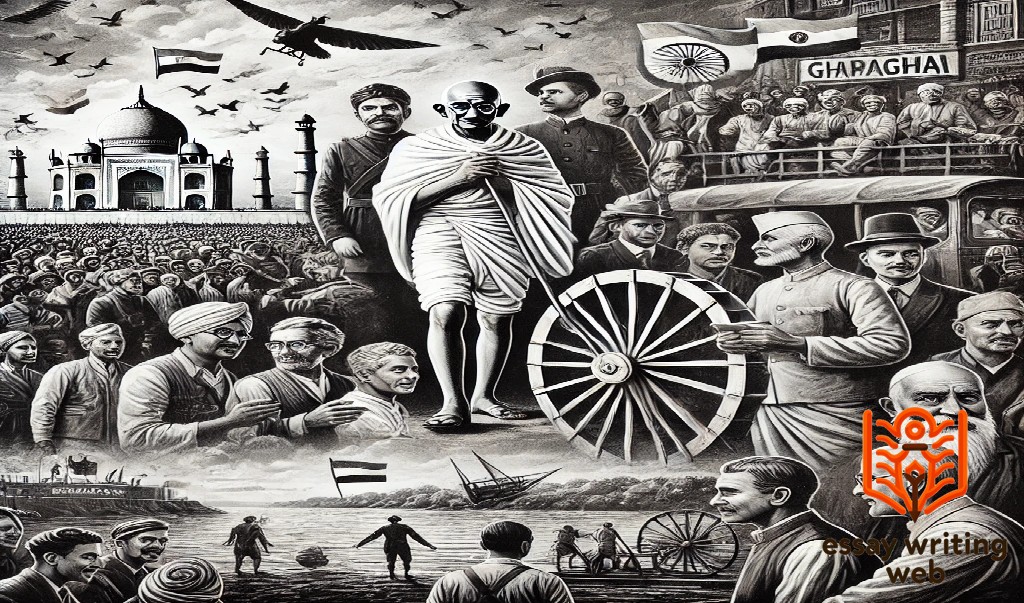
Mahatma Gandhi was not only a leader in India's struggle for independence but also a powerful advocate for social reform. His vision of India’s freedom was not merely political but also encompassed social justice, equality, and moral upliftment. Throughout his life, Gandhi worked tirelessly to address deep-rooted social issues, including untouchability, the empowerment of women, rural development, and communal harmony. His efforts in social reforms reflected his belief that true freedom could only be achieved when society was liberated from its internal inequities and injustices.
One of Gandhi's most significant contributions to social reform was his fight against untouchability. He believed that the caste system, particularly the treatment of the "untouchables" (whom he called Harijans, or "children of God"), was one of the most degrading aspects of Indian society. Gandhi actively campaigned for the rights of the Harijans, advocating for their inclusion in temples, schools, and public spaces. He led movements to abolish untouchability and encouraged people to treat every individual with dignity and respect, regardless of their caste. His efforts helped elevate the status of the marginalized and laid the groundwork for future legal and social reforms in India.
Gandhi also placed great emphasis on the empowerment of women. He believed that women had an essential role to play in the nation’s progress and advocated for their education and participation in public life. He encouraged women to join the freedom struggle and break away from the traditional roles imposed on them by society. Leaders like Sarojini Naidu, Kasturba Gandhi, and Kamala Nehru were among the many women who rose to prominence during the independence movement, inspired by Gandhi’s call for their active involvement.
Rural development was another core aspect of Gandhi’s social reform agenda. He believed that India’s heart lay in its villages and that true progress could only be achieved through the upliftment of rural areas. His concept of Swadeshi—a self-sufficient economy based on local resources—promoted village industries, particularly the spinning of cotton (Charkha), as a means to achieve economic independence and reduce reliance on British goods. Gandhi envisioned a decentralized society where every village was self-reliant, prosperous, and rooted in ethical principles.
Gandhi also worked relentlessly to foster communal harmony. He believed that Hindus, Muslims, and people of all religions should live together in peace and mutual respect. His campaigns for unity were crucial in addressing the religious divides that plagued Indian society, especially during the later years of the independence struggle.
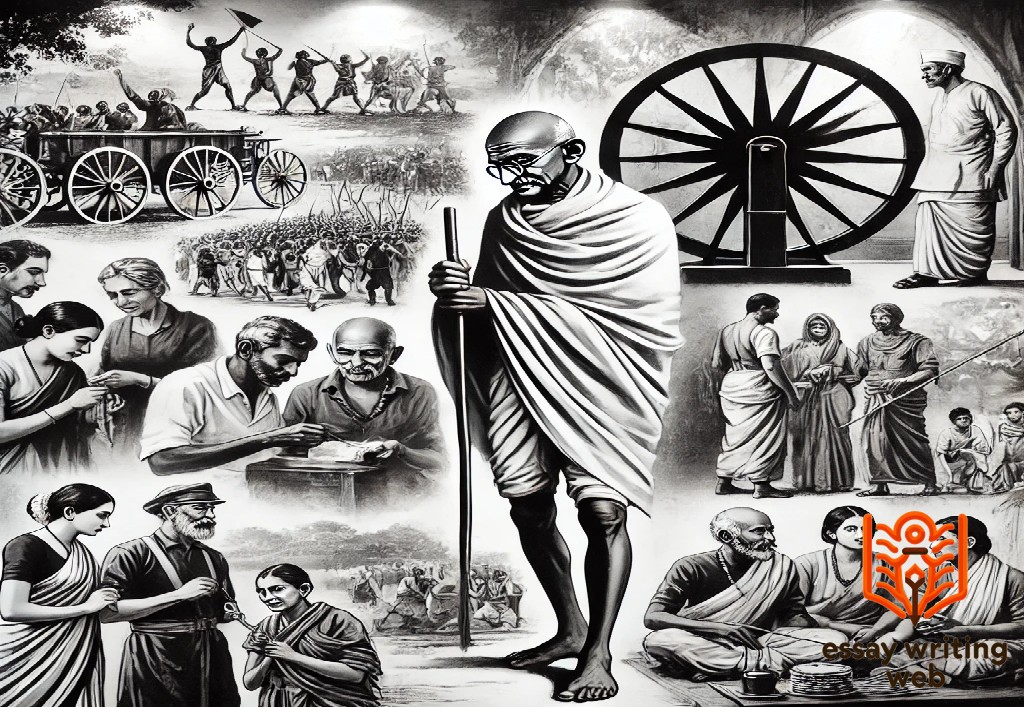
Mahatma Gandhi’s vision for independent India extended far beyond political freedom from British colonial rule. His ideas were deeply rooted in moral, social, and economic values aimed at creating an egalitarian and self-reliant society. Gandhi believed that true independence (Swaraj) could only be achieved if every Indian, regardless of caste, creed, or gender, could live a life of dignity, freedom, and self-sufficiency. His vision was built on the principles of non-violence (Ahimsa), truth (Satya), and a decentralized economy, which together would form the foundation of a prosperous and just nation.
One of the core pillars of Gandhi’s vision for India was self-reliance. He emphasized the importance of Swadeshi, the promotion of locally produced goods and services, and advocated for the revival of traditional Indian industries, particularly hand-spinning and weaving through the use of the Charkha (spinning wheel). He believed that India’s villages should be self-sufficient and independent, producing their own food, clothing, and other essentials. For Gandhi, the empowerment of rural India was key to economic independence. He saw India as a country of villages, and his goal was to uplift the poorest sections of society by encouraging local production and reducing dependence on foreign goods.
Mahatma Gandhi also envisioned a society that was free from social discrimination and inequality. He worked tirelessly to eradicate untouchability and sought to create a society where people of all castes and communities could live in harmony. His belief in Sarvodaya—the welfare of all—guided his approach to social reform. Gandhi envisioned an inclusive India, where marginalized communities like the Harijans (untouchables) and women had equal rights and opportunities to participate in nation-building.
Non-violence and peaceful coexistence were also at the heart of Gandhi’s vision for India. He believed that the country’s independence should be achieved through non-violent means, and this philosophy extended into his vision for the future. Gandhi wanted India to be a beacon of peace in the world, resolving conflicts without resorting to violence. He believed that India could set an example for other nations by practicing non-violence, both domestically and in its foreign relations.
In terms of governance, Gandhi opposed a highly centralized state and instead favored a system of decentralized governance, where local communities had control over their own affairs. He believed that true democracy could only thrive if people were actively involved in decision-making at the grassroots level.
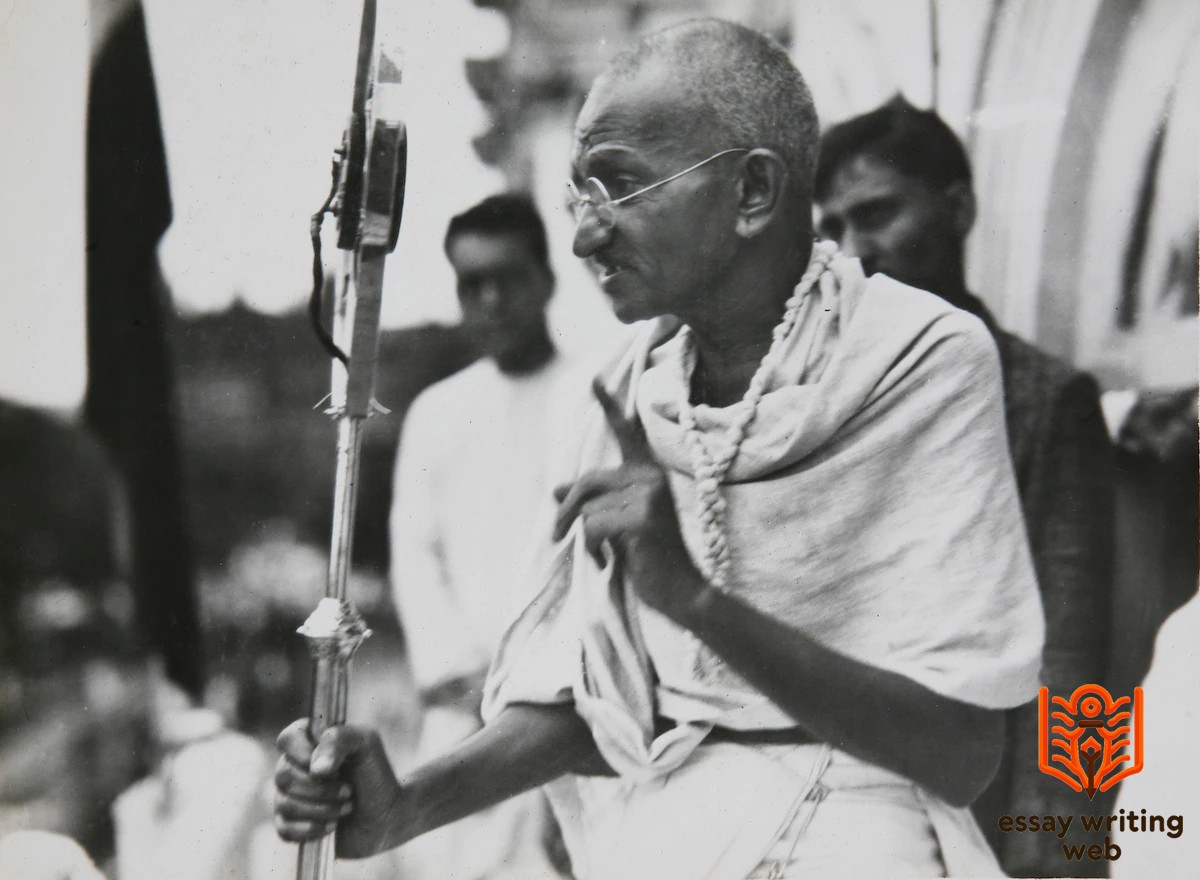
The Salt Satyagraha, also known as the Salt March, was one of the most iconic and significant events in India's struggle for independence led by Mahatma Gandhi in 1930. This act of non-violent resistance was a direct challenge to the oppressive British colonial rule, specifically targeting the British salt monopoly and its unfair taxation on salt, an essential commodity. The Salt Satyagraha became a turning point in the Indian independence movement, galvanizing the masses and showcasing the power of non-violent civil disobedience.
At the time, the British government imposed heavy taxes on salt production and restricted Indians from producing or selling their own salt. This salt tax affected all Indians, especially the poor who relied on salt as a basic necessity. Gandhi recognized the unjust nature of this law and saw salt as a symbol of the broader economic exploitation of India by the British. By choosing salt as the focal point of protest, Gandhi tapped into a grievance that resonated with all Indians, regardless of their socio-economic background.
On March 12, 1930, Gandhi set out on a 24-day march from his ashram in Sabarmati to the coastal village of Dandi, covering over 240 miles. Accompanied by 78 of his followers, Gandhi’s march quickly gained national and international attention. As he traveled through villages, thousands of people joined the march, transforming it into a massive civil disobedience movement. On April 6, 1930, upon reaching Dandi, Gandhi symbolically defied British law by picking up a handful of salt from the seashore. This simple act of defiance ignited widespread protests across the country, with millions of Indians participating in salt production, boycotting British goods, and organizing mass demonstrations.
The Salt Satyagraha was not just a protest against the salt tax; it was a broader statement against colonial oppression and exploitation. Gandhi's non-violent approach, known as Satyagraha, was based on the belief that truth and non-violence could overcome injustice. He urged Indians to engage in civil disobedience peacefully, even in the face of British repression. The Salt Satyagraha demonstrated the effectiveness of this strategy, as it drew massive participation from people across all strata of Indian society, including women, peasants, and workers.
The British response to the Salt Satyagraha was harsh. Over 60,000 people, including Gandhi, were arrested. Despite this repression, the movement continued to grow, with more people joining the protests and boycotts. Gandhi's imprisonment only fueled the resolve of the Indian people, and the Salt Satyagraha became a symbol of India's determination to achieve freedom through peaceful means.
While the Salt Satyagraha did not immediately lead to the repeal of the salt tax or the end of British rule, it marked a critical juncture in the independence movement. It exposed the moral and political weaknesses of British rule and showed the world the strength of India's non-violent resistance. Internationally, the Salt Satyagraha drew attention to India’s independence struggle, garnering sympathy and support from leaders and movements around the globe. The campaign also influenced later civil rights movements, inspiring figures like Martin Luther King Jr. and Nelson Mandela in their respective fights against racial and colonial oppression.

